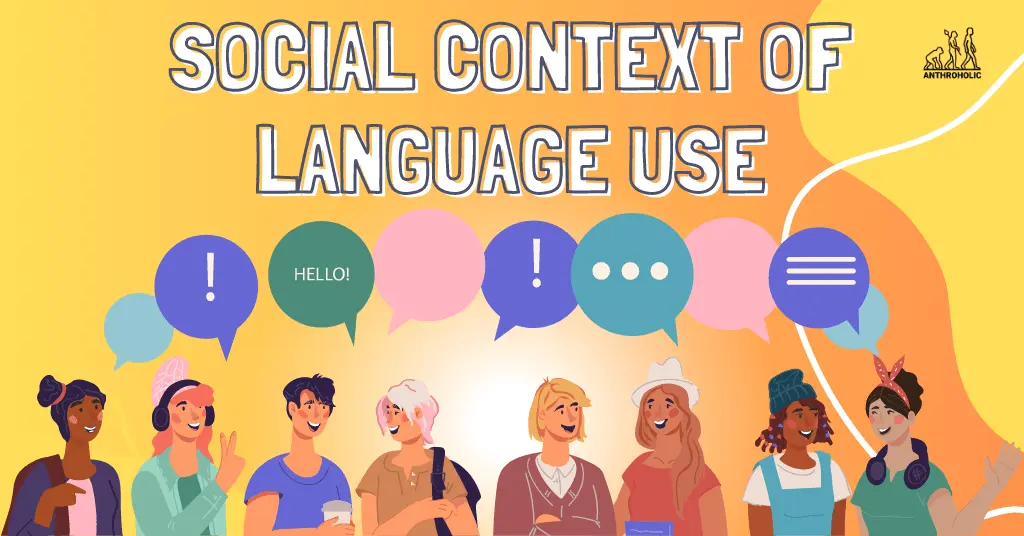AI Answer Evaluation Platform Live Now. Try Free Answer Evaluation Now
Social Context of Language Use
Language is an essential tool for communication, and its use is heavily influenced by the social context in which it is employed. The social context of language use refers to the various factors that shape how individuals use language to communicate, including culture, social relationships, power dynamics, and the specific situation in which communication occurs.

Cultural Factors
Culture plays a significant role in shaping language use, as it determines the norms, values, and conventions associated with communication in a given society. Some of the ways in which culture influences language use include:
- Language variation: Different cultures have distinct languages or dialects, which can affect how individuals communicate and understand one another [9].
- Politeness and formality: Cultural norms dictate the appropriate levels of politeness and formality in communication, influencing how individuals address one another and express themselves [1].
- Nonverbal communication: Cultures vary in their use of nonverbal cues, such as gestures, facial expressions, and body language, which can impact how messages are conveyed and interpreted [6].
Social Relationships
The nature of social relationships between communication partners also influences language use. Factors related to social relationships include:
- Social distance: The level of familiarity between individuals affects their language use, with greater social distance often leading to more formal language [4].
- Social identity: Individuals may use language to signal their social identity or group membership, such as through the use of jargon, slang, or specific language features [8].
- Power dynamics: Differences in social status or power can influence language use, with those in positions of authority often using more formal or directive language [3].
Situational Factors
The specific situation in which communication occurs also plays a role in shaping language use. Some situational factors that impact language use are:
- Setting: The physical context (e.g., a workplace, classroom, or social gathering) can influence the formality and content of language used [7].
- Purpose: The intended goal of communication (e.g., to inform, persuade, or entertain) can affect the choice of language features and strategies employed [5].
- Medium: The mode of communication (e.g., face-to-face, written, or digital) can impact language use, with different mediums requiring different levels of formality and adherence to linguistic conventions [2].
| Aspect | Description |
|---|---|
| Cultural Factors | Influence of culture on language variation, politeness, formality, and nonverbal communication |
| Social Relationships | Impact of social distance, identity, and power dynamics on language use |
| Situational Factors | Role of setting, purpose, and medium in shaping language use |
Conclusion
In summary, by understanding the roles of culture, social relationships, and situational factors, researchers and practitioners can better appreciate the complexities of language use in diverse social settings. This knowledge is crucial for fostering effective communication and overcoming potential barriers in understanding and interpreting messages across different contexts.
References
[1] Brown, P., & Levinson, S. C. (1987). Politeness: Some universals in language usage. Cambridge University Press.
[2] Crystal, D. (2001). Language and the Internet. Cambridge University Press.
[3] Fairclough, N. (1989). Language and Power. Longman.
[4] Giles, H. (1973). Accent Mobility: A Model and Some Data. Anthropological Linguistics, 15(2), 87-105.
[5] Grice, H. P. (1975). Logic and Conversation. In P. Cole & J. L. Morgan (Eds.), Syntax and Semantics 3: Speech Acts (pp. 41-58). Academic Press.
[6] Hall, E. T. (1966). The Hidden Dimension. Doubleday.
[7] Hymes, D. (1974). Foundations in Sociolinguistics: An Ethnographic Approach. University of Pennsylvania Press. “Foundations in Sociolinguistics.” Google Books, https://books.google.com/books/about/Foundations_in_Sociolinguistics.html?id=B3NIAeabrHwC
[8] Labov, W. (1966). The Social Stratification of English in New York City. Center for Applied Linguistics.
[9] Wardhaugh, R. (2010). An Introduction to Sociolinguistics (6th ed.). Wiley-Blackwell. https://www.academia.edu/31761449/An_Introduction_to_Sociolinguistics



